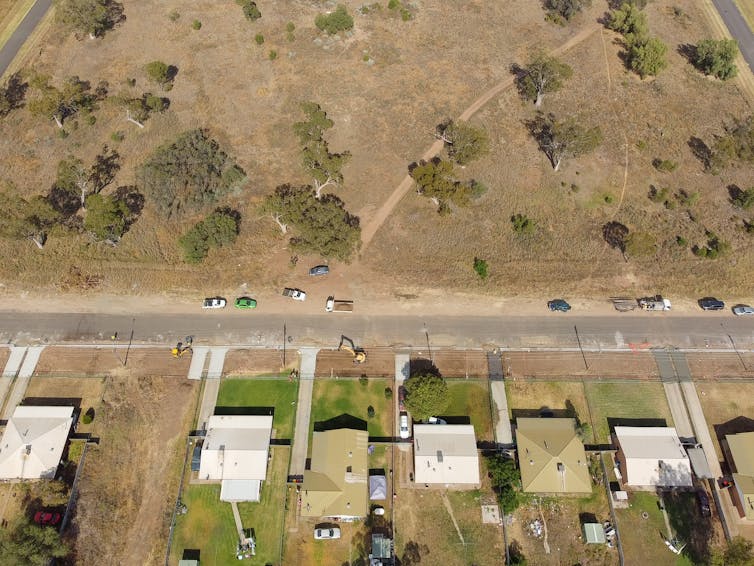Aboriginal housing policies must be based on community needs — not what non-Indigenous people think they need
- Written by Martin Loosemore, Professor of Construction Management, University of Technology Sydney
The recently announced $250 million NSW budget boost for Aboriginal housing is much welcomed and long overdue.
In implementing this important new initiative, it is critical to consult Aboriginal communities about what culturally appropriate housing looks like. In the past, public housing policies have often been imposed on Aboriginal communities based on non-Aboriginal ideals of good housing.
Research findings show the social values of Aboriginal people differ significantly from non-Aboriginal values. Unfortunately, well-intentioned government policies too often ignore these crucial differences.
The Universal Declaration of Human Rights says everyone has the right to decent housing, which provides for their security, health and well-being.
However, past policies have not done enough to ensure Aboriginal people have adequate housing — it continues to lag behind non-Aboriginal housing across Australia.
Barriers to housing for Aboriginal and Torres Strait Islander people
In 2020, the National Agreement on Closing the Gap included housing among its 16 key socio-economic targets to improve life outcomes for Aboriginal and Torres Strait Islander people.
However, the Australian Housing and Urban Research Institute recently found closing the gap targets cannot be met without addressing the current lack of affordable and quality housing.
As it stands:
a much higher proportion of Aboriginal and Torres Strait Islander people live in overcrowded and public housing
only 42% own their own home compared with 65% of non-Indigenous households
housing shortages are predicted to increase to 90,901 dwellings across Australia by 2031, of which 65,000 are in NSW
However, the use of financial metrics (such as the amount of money spent on Aboriginal housing) to determine the success of Aborginal housing policies can sometimes present a deceiving and biased view of the impact they have on Aboriginal communities.
It is critical the success of any Aboriginal policy is measured in a way which reflects Aboriginal cultural connections to country and kinship. These measurements should not reflect non-Aboriginal values of individualism and materialism, which typically guide government assessments of success and failure.
This is why it was reassuring to hear NSW Treasurer Dominic Perrottet state:
This budget is not just about dollars; it is about our commitment to ensure funding is directed to the areas where it can make the most difference for Aboriginal communities across our state.
It remains to be seen, though, whether the NSW government has the tools and knowledge to assess and communicate the success of policies affecting Aboriginal people in this way.
Important lessons for Aboriginal housing policy
Our research at the Indigenous Infrastructure and Sustainable Housing Alliance, in partnership with the NSW Department of Planning, Industry and Environment, shows decent housing is critical for the health and well-being of Aboriginal communities.
The negative impacts of culturally inappropriate and poor-quality housing on the health and well-being of Aboriginal and Torres Strait Islander people, especially young people, has been well-known for many decades.
Well-intentioned housing policies that are inappropriately designed and implemented can represent yet another form of controlling and monitoring of Aboriginal communities.
We have found a large number of housing problems for Aboriginal people, which can be summarised into four main areas:
overcrowding
ageing housing stock
poor quality construction and maintenance (especially waterproofing)
inappropriate standardised designs which do not reflect Aboriginal cultural values and family structures.
Our evaluation of the NSW’s Roads to Home Program also highlights the importance of addressing underlying infrastructure deficiencies in Aboriginal communities.
Poorly maintained and constructed roads, footpaths, drains, and electricity and telecommunications systems present potential risks to peoples’ health, safety, security and wellbeing. And this, in turn, creates structural disadvantage and further isolates them from surrounding non-Aboriginal communities
It is good to see much-needed upgrades to infrastructure, such as drainage, roads and footpaths, continuing at a cost of $34.1 million over three years under the program.
The program also invests in road and infrastructure upgrades in Aboriginal communities, such as former reserves and missions. It commenced in July 2019, with ten communities being initially upgraded over a four-year period at a cost of $54.8 million.
 The community of Gulargambone, part of the research’s Roads to Home evaluation.
James Melsom, University of Technology Sydney, Author provided (no reuse)
The community of Gulargambone, part of the research’s Roads to Home evaluation.
James Melsom, University of Technology Sydney, Author provided (no reuse)
What culturally responsive housing can look like
We have developed a series of design principles to inform culturally responsive housing designs currently under development in northwestern NSW.
These principles can be simplified under three main headings:
orientation (building and block orientation)
house layout (how the house is laid out internally)
materials (durability, ease of maintenance)
To address the legacy of past Aboriginal housing policies new Aboriginal housing should reflect the diverse cultures, climate variations and environments of Aboriginal communities. They must not be built around the traditional, western, nuclear family model. Housing should be resilient, sustainable and provide flexible and adaptable spaces for extended families and community activities.
Importantly, they must also comply with the Building Code of Australia since too much Aboriginal housing has been built below Australian standards.
In building community resilience, hope and prosperity, our research also shows any new Aboriginal housing should also be implemented alongside social procurement policies. This ensures future projects provide meaningful and sustainable training and employment opportunities for the people who live in these communities.
However, governments must be committed to enforcing these policies and measuring their impact from Aboriginal people’s perspectives.
Most importantly, Aboriginal housing policies should be developed and implemented in close consultation with Aboriginal people, recognising each community’s unique cultures, needs and priorities.
Authors: Martin Loosemore, Professor of Construction Management, University of Technology Sydney





